Book 4 Unit 4 阅读 教案 (2)
- 格式:doc
- 大小:81.00 KB
- 文档页数:14
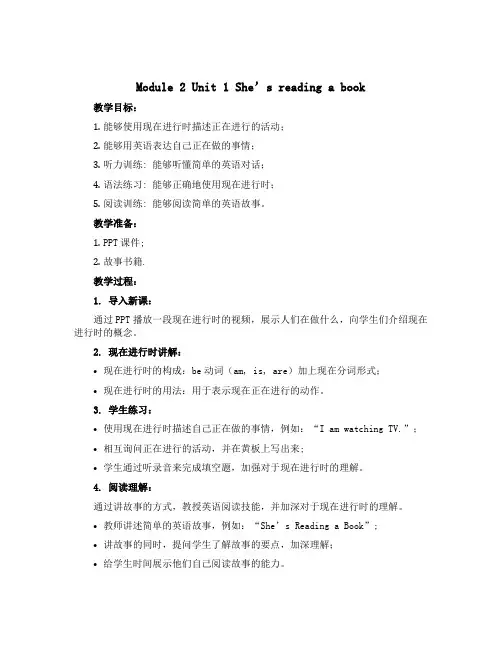
Module 2 Unit 1 She’s reading a book教学目标:1.能够使用现在进行时描述正在进行的活动;2.能够用英语表达自己正在做的事情;3.听力训练: 能够听懂简单的英语对话;4.语法练习: 能够正确地使用现在进行时;5.阅读训练: 能够阅读简单的英语故事。
教学准备:1.PPT课件;2.故事书籍.教学过程:1. 导入新课:通过PPT播放一段现在进行时的视频,展示人们在做什么,向学生们介绍现在进行时的概念。
2. 现在进行时讲解:•现在进行时的构成:be动词(am, is, are)加上现在分词形式;•现在进行时的用法:用于表示现在正在进行的动作。
3. 学生练习:•使用现在进行时描述自己正在做的事情,例如:“I am watching TV.”;•相互询问正在进行的活动,并在黄板上写出来;•学生通过听录音来完成填空题,加强对于现在进行时的理解。
4. 阅读理解:通过讲故事的方式,教授英语阅读技能,并加深对于现在进行时的理解。
•教师讲述简单的英语故事,例如:“She’s Reading a Book”;•讲故事的同时,提问学生了解故事的要点,加深理解;•给学生时间展示他们自己阅读故事的能力。
5. 互动游戏:•学生分成小组,在白板上写出一些正在进行的活动;•学生互相猜测对方写的活动,并全部使用现在进行时来描述;•最终,老师收回白板,点评学生们表现;6. 课堂总结:通过回答问题,进一步加深学生对于现在进行时的理解。
教学反思:此次教学通过多种方式来加深学生对于现在进行时的理解。
教师讲故事,让学生了解并学会使用现在进行时;通过小组游戏加强学生对于句子的理解;最后通过回答问题,加深对于知识点的理解。
在教学过程中,应该让学生积极参与,激发学生的学习兴趣,让英语学习更有趣。
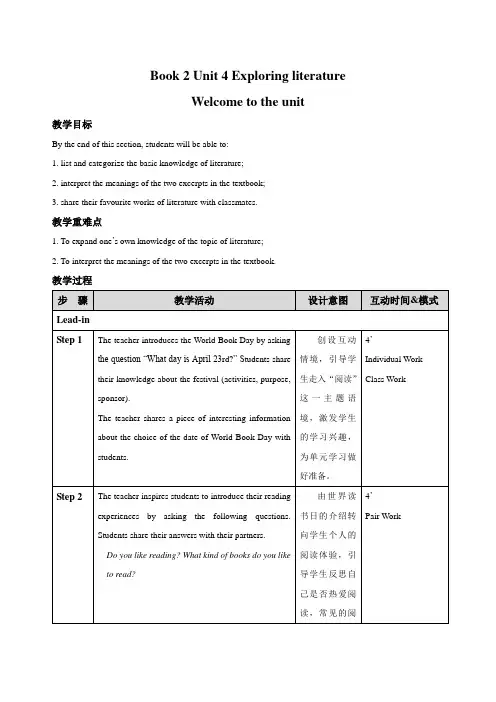
Book 2 Unit 4 Exploring literatureWelcome to the unit教学目标By the end of this section, students will be able to:1. list and categorize the basic knowledge of literature;2. interpret the meanings of the two excerpts in the textbook;3. share their favourite works of literature with classmates.教学重难点1. To expand one’s own knowledge of the topic of literature;2. To interpret the meanings of the two excerpts in the textbook.教学过程读种类有哪些,为接下来有关文学信息的讨论做铺垫。
Homework checkingStep 3 Before class, the teacher has asked students to surf the Internet or refer to some reference books to get someinformation about literature. Topics related to literaturemay include genres of literature, famous writers andtheir works and famous quotes, etc. Students work ingroups and report their works in the form of amind-map.引导学生自主探究总结出有关文学的基本信息,并开展小组合作,将组员收集的各种信息利用思维导图进行梳理和整合。
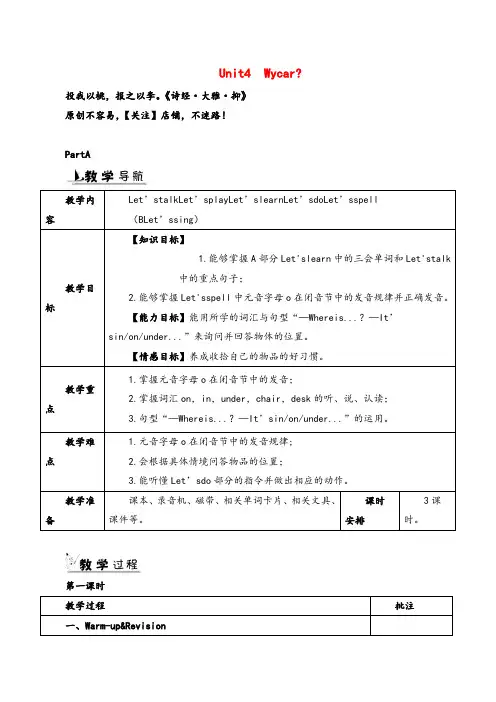
Unit4 Wycar? 投我以桃,报之以李。
《诗经·大雅·抑》原创不容易,【关注】店铺,不迷路!PartA教学内容Let’stalkLet’splayLet’slearnLet’sdoLet’sspell (BLet’ssing)教学目标【知识目标】1.能够掌握A部分Let'slearn中的三会单词和Let'stalk中的重点句子;2.能够掌握Let'sspell中元音字母o在闭音节中的发音规律并正确发音。
【能力目标】能用所学的词汇与句型“—Whereis...?—It’sin/on/under...”来询问并回答物体的位置。
【情感目标】养成收拾自己的物品的好习惯。
教学重点1.掌握元音字母o在闭音节中的发音;2.掌握词汇on,in,under,chair,desk的听、说、认读;3.句型“—Whereis...?—It’sin/on/under...”的运用。
教学难点1.元音字母o在闭音节中的发音规律;2.会根据具体情境问答物品的位置;3.能听懂Let’sdo部分的指令并做出相应的动作。
教学准备课本、录音机、磁带、相关单词卡片、相关文具、课件等。
课时安排3课时。
第一课时教学过程批注一、Warm-up&Revision第二课时第三课时二、Presentation&Practice1.在课件上展示盒子图片,说:“Thisisabox.”板书box并带读。
2.在课件上展示小狗在盒子里面的图片。
T:What’sthis?(用手指着小狗)Ss:It’sadog.T:Whereisthedog?Ss:It’sinthebox.板书dog并带读。
3.在课件上呈现一个橙子的图片,说:“Thisisanorange.It’sorange.”板书orange并带读。
4.教师拍拍自己的身体说:“Look!Thisismybody.”板书body并带读。
5.播放Listen,repeatandcber.部分的八个单词,提醒学生注意字母o 的发音。

《剑桥国际少儿英语》第二册教案
单元目标语言:
语词:mat, lamp, clock, phone, sofa, mirror, Ellie elephant, 发音/e/
结构:It’s /They’re yours/mine. Which (T-shirt)? Whose are those?
单元技能目标:
听:能够听懂谈论关于房子里的物品及其位置的对话和带有yours和mine的句子,能将字母e与/e/音联系起来说:能够谈论房子里的物品及其位置,能够利用yours和mine谈论所有物,能够识别/e/音
读:能够认读表示房子里物品的单词,能够识别用yours和mine表示所有物的句子
写:能够拼写出表示房子里物品的单词和表示所属关系的yours和mine
第一课时Lesson 1
课堂教学过程(40 mins)
第二课时Lesson 2
课堂教学过程(40 mins)
第三课时Lesson 3
课堂教学过程(40 mins)
第四课时Lesson 4
课堂教学过程(40 mins)
第五课时Lesson 5
课堂教学过程(40 mins)
第六课时Lesson 6
课堂教学过程(40 mins)。
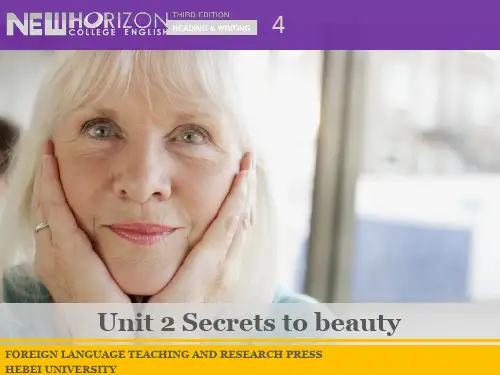
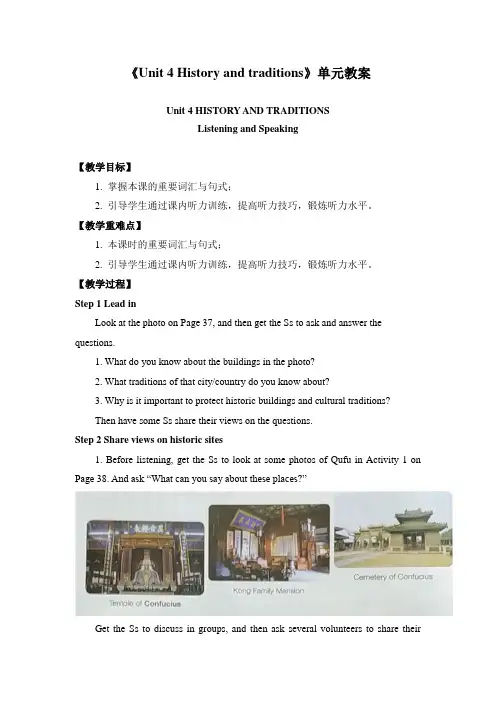
《Unit 4 History and traditions》单元教案Unit 4 HISTORY AND TRADITIONSListening and Speaking【教学目标】1. 掌握本课的重要词汇与句式;2. 引导学生通过课内听力训练,提高听力技巧,锻炼听力水平。
【教学重难点】1. 本课时的重要词汇与句式;2. 引导学生通过课内听力训练,提高听力技巧,锻炼听力水平。
【教学过程】Step 1 Lead inLook at the photo on Page 37, and then get the Ss to ask and answer the questions.1. What do you know about the buildings in the photo?2. What traditions of that city/country do you know about?3. Why is it important to protect historic buildings and cultural traditions?Then have some Ss share their views on the questions.Step 2 Share views on historic sites1. Before listening, get the Ss to look at some photos of Qufu in Activity 1 on Page 38. And ask “What can you say about these places?”Get the Ss to discuss in groups, and then ask several volunteers to share theirviews with the class.2. Listen to a conversation between a British tourist and a Chinese student in Qufu, and then write down what they say about Confucius.Finally check the answers with the class.3. Listen again and decide whether these statements are true (T), false (F), or not mentioned (NM).(1) Listen and judge, and check the answers.1) Confucius said that learning without understanding leads to confusion.2) Xiao Kong is doing a research project on Confucius philosophy.3) As one of Confucius’ descendants, Xiao Kong’s name is recorded in the family tree.4) Dacheng Hall is the tallest building in Qufu.(2) Then go through the question as bellow, and choose the right answer.·Why do you think William said his hometown was similar to Qufu?A. There are famous halls in his hometown.B. There are no tall buildings in his hometown.C. Both places have a famous person who was born there.D. His hometown doe sn’t allow other buildings to be more noticeable than the historic buildings.4. Activity 4(1) At first, go through the Understand idioms with the Ss.An idiom is an expression which means something different from the meaning of the individual words. Some idioms present an idea or paint a picture that gives a hint as to the meaning. Other idioms can only be understood from the context in which they appear.(2) Write down the English idioms that are used in the conversation. Explaintheir meanings and think about some Chinese equivalents.5. Discuss the questions in groups, and then get some Ss to share their answers.(1) What do you know about Confuciu s’ ideas on education? Think of two or three examples. What else do you know about Confucius and his philosophy?(2) Think about a historic site that you have visited, and give an introduction to its history and importance.Step 3 Pronunciation1. Read thi s part of the poem “If-” written by British poet Rudyard Kipling.Notice the linking sounds. Then mark the linking sounds after the modelIf you can make one heap of all your winningsAnd risk it on one turn of pitch-and-toss,And lose, and start again at your beginningsAnd never breathe a word about your loss;If you can force your heart and nerve and sinewTo serve your turn long after they are gone,And so hold on when there is nothing in youExcept the Will which says to them: "Hold on!"2. Repeat the poem after the recording.Step 4 Homework课后练习Unit 4 HISTORY AND TRADITIONSReading and Thinking【教学目标】1. 理解并熟练掌握本课的重要词汇与句式;2. 引导学生通过课内阅读,了解英国的历史,全面培养学生的阅读能力和技巧。

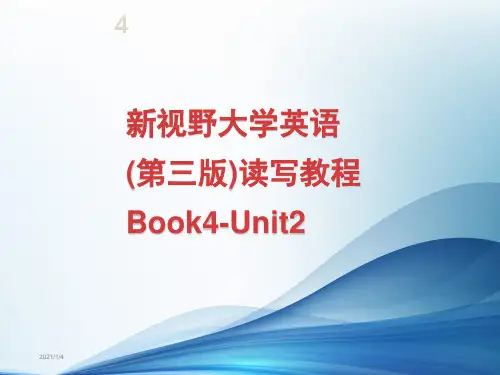
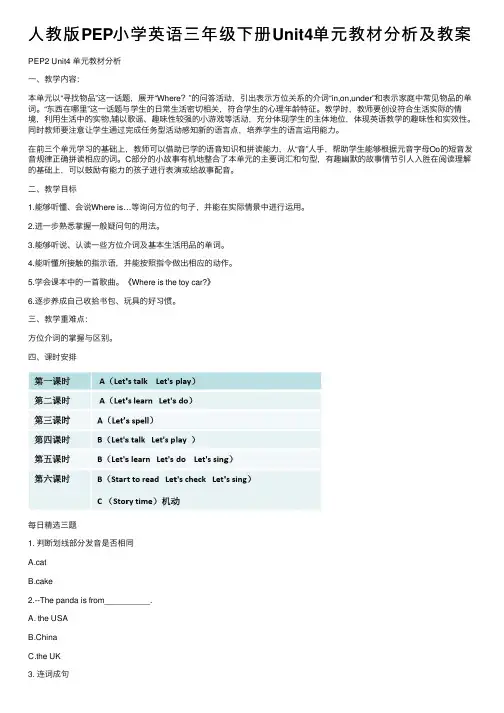
⼈教版PEP⼩学英语三年级下册Unit4单元教材分析及教案PEP2 Unit4 单元教材分析⼀、教学内容:本单元以“寻找物品”这⼀话题,展开“Where?”的问答活动,引出表⽰⽅位关系的介词“in,on,under”和表⽰家庭中常见物品的单词。
“东西在哪⾥”这⼀话题与学⽣的⽇常⽣活密切相关,符合学⽣的⼼理年龄特征。
教学时,教师要创设符合⽣活实际的情境,利⽤⽣活中的实物,辅以歌谣、趣味性较强的⼩游戏等活动,充分体现学⽣的主体地位,体现英语教学的趣味性和实效性。
同时教师要注意让学⽣通过完成任务型活动感知新的语⾔点,培养学⽣的语⾔运⽤能⼒。
在前三个单元学习的基础上,教师可以借助已学的语⾳知识和拼读能⼒,从“⾳”⼈⼿,帮助学⽣能够根据元⾳字母Oo的短⾳发⾳规律正确拼读相应的词。
C部分的⼩故事有机地整合了本单元的主要词汇和句型,有趣幽默的故事情节引⼈⼊胜在阅读理解的基础上,可以⿎励有能⼒的孩⼦进⾏表演或给故事配⾳。
⼆、教学⽬标1.能够听懂、会说Where is…等询问⽅位的句⼦,并能在实际情景中进⾏运⽤。
2.进⼀步熟悉掌握⼀般疑问句的⽤法。
3.能够听说、认读⼀些⽅位介词及基本⽣活⽤品的单词。
4.能听懂所接触的指⽰语,并能按照指令做出相应的动作。
5.学会课本中的⼀⾸歌曲。
《Where is the toy car?》6.逐步养成⾃⼰收拾书包、玩具的好习惯。
三、教学重难点:⽅位介词的掌握与区别。
四、课时安排每⽇精选三题1. 判断划线部分发⾳是否相同A.catB.cake2.--The panda is from__________.A. the USAB.ChinaC.the UK3. 连词成句①he ②Is ③father ④your ⑤(?)______________________________________________________ PEP Book2 Uni4 Where is my car?Part A Let’s talk⼀、教学内容PEP Book2 Unit4 A Let’s talk and Let’s play⼆、教学⽬标1.能听懂、会说并理解句⼦Where's ...? It's in / on / under....2.在创设的情景中,能⽤ Where's ...? 询问某物在哪⾥,并做简单回答。
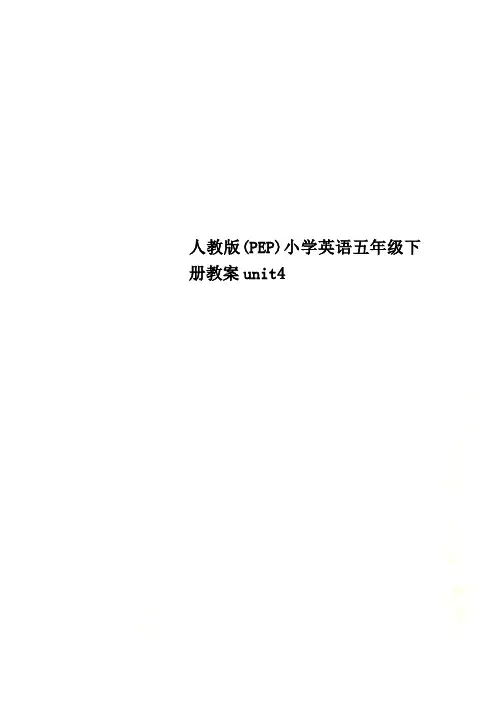
人教版(PEP)小学英语五年级下册教案unit4五年级英语总第教时集体备课小组成员:余新月Unit4 What are you doing课题第一课时Let’s lean Let’s chant 课型New lesson教学目标知识目标:能够听、说、读、写动词短语的ing 形式:drawingpictures , doing the dishes , cooking dinner ,reading a book , answering the phone 。
能力目标:能运用句子“What are you doing ? I am doingthe dishes/…”询问别人正在做什么并作答。
情感目标:培养学生热爱生活的美好情感。
教学重点掌握五个动词短语的ing 形式,能够理解下一课时的主要句型:What are you doing 并能够用I am doing the dishes/…作答教学难点动词短语ing形式的读音教学用具Recorder,cards 教学方法讲授法、教学过程设计教学环节教师活动学生活动设计意图Step 1: Warm upStep 2:Presentation (1)教师放歌曲“What are youdoing ”的录音。
(2)日常口语练习。
T:What can youdo?T:Can you do thedishes?(1)教师再次拿出do the dishes的卡片,同时在黑板上写下do thedishes,教师边做洗碗的动作,边对学生说: I amdoing thedishes . 然后在黑板上的短语后面加上ing变成doing thedishes . 教师引导学生做洗碗的动作,并跟说:Metoo . 然后继续用其他的卡片进行替换,通过适当的动作引导学生理解现在进行时表达的含义.(2)出示动作卡片,通过让学生说动作短语,并将动作短语转换成ing的形式.(3)给学生提供调色盘、电话、碗碟等小道具,教师问:What are youdoing ?引导学生S1:I can wash theclothes.S2: I can make thebed.Ss: Yes ,I can带领学生继续操练。
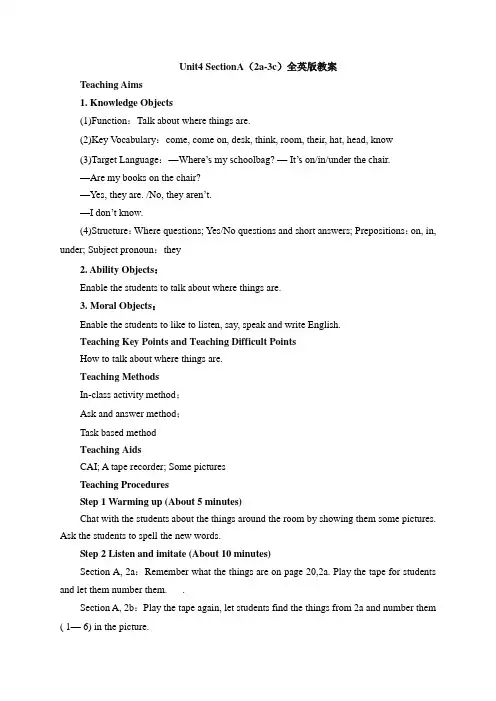
Unit4 SectionA(2a-3c)全英版教案Teaching Aims1. Knowledge Objects(1)Function:Talk about where things are.(2)Key V ocabulary:come, come on, desk, think, room, their, hat, head, know(3)Target Language:—Where’s my schoolbag?—It’s on/in/under the chair.—Are my books on the chair?—Yes, they are. /No, they aren’t.—I don’t know.(4)Structure:Where questions; Yes/No questions and short answers; Prepositions:on, in, under; Subject pronoun:they2. Ability Objects:Enable the students to talk about where things are.3. Moral Objects:Enable the students to like to listen, say, speak and write English.Teaching Key Points and Teaching Difficult PointsHow to talk about where things are.Teaching MethodsIn-class activity method;Ask and answer method;Task based methodTeaching AidsCAI; A tape recorder; Some picturesTeaching ProceduresStep 1 Warming up (About 5 minutes)Chat with the students about the things around the room by showing them some pictures. Ask the students to spell the new words.Step 2 Listen and imitate (About 10 minutes)Section A, 2a:Remember what the things are on page 20,2a. Play the tape for students and let them number them. .Section A, 2b:Play the tape again, let students find the things from 2a and number them ( 1— 6) in the picture.Section A, 2c:Ask and answer questions about the things in the picture in 2be. g. :A:Are the keys on the sofa?B:No, they aren’t. They’re on the table.Step 3 A guessing game (About 5 minutes)Show the students a picture of a room with a few things in it. Have them guess the places of the other things.e. g. :T:There is a bookcase in it. Is the bookcase near the bed?Ss:Yes, it is. /No, it isn’t.Write the general question and the answers on the blackboard.Step 4 Pair work (About 10 minutes)Section A,2d:Role—play the conversation.Section A, 3a:look at the picture and complete the conversations, then work in pairs and act out the conversations.Section A, 3b:Ask and answer questions about the things in 3b.Step 5 Find the difference (About 8 minutes)Student A looks at Picture 1 in la on page 19, student B looks at Picture 2 in 3e on page 21, Ask and answer in pairs and fill in the form.e. g. :SA:Where is the schoolbag? Is it under the table?SB:No, it isn’t. It, s. on the table.In Picture l, the book case isIn Picture 2, the book ease is…In Picture 1, the books are…In Picture 2, the books are…。
Unit4 课文挖空学案(2)SEEING THE TRUE NORTH VIA RAILTORONTO AND MONTREAIAfter Li Daiyu and her cousin arrived in Toronto, the largest and _________(wealthy) city in Canada, they only had a few hours _______( kill) before they had to ________(行进)to the next leg of their trip ______Montreal, so they went on a tour of the city. They went up the CN Tower and looked across the ________(海滨)of Lake Ontario. ________(站在远处), they were _______(astonish) to see mist clouds _______(rise) from the great Niagara Falls, ______ is on the south side of the lake. Water from the lake _______(flow) into the Niagara River and over the falls on its way _____ the sea.The girls saw hundreds of skyscrapers of glass and ______(钢), and old-fashioned cars______ (roll) by. _______ they walked north from the harbour area, Li Daiyu said, "Lin Fei, one of my mother's old schoolmates,_______(live) here. I should phone her and see ______she's available (含义:________)for dinner.”They met Lin Fei around _______(黄昏) over dinner at a restaurant in downtown Chinatown. The cousins ______(chat) with Lin Fei who had moved to Canada many years earlier." This is the largest Chinatown in Toronto. We have a few more in the Greater Toronto Area, so you can guess _______ there are a lot of Chinese people in Canada! Chinese people ___________(come) here for more than a hundred years. ________, we can get all kinds of great food here from all over China, "Lin Fei told them.The train ______(leave) late that night and arrived in Montreal early the next morning. At the station in contrast ______Toronto, they heard people talking ______ French. They were surprised to see that all the signs and ________(advertise) were in French and many people spoke English with an_______(口音)."We don' t leave ______ this evening, "said Liu Qian. Let's go downtown. Old Montreal is close _____ the water.”They spent the afternoon in lovely shops and _________(visit) artists in their workplaces _______ St Paul Street. As they sat in a restaurant ________(在......旁边)the broad St Lawrence River, a young man sat down with them.“Hello, my name is Jean-Philippe. I’m a _________(photograph),” he said, "and I was wondering ______ you are from."The girls told him they were from China and were on a train trip ________Canada. When they told h im they had only one day in Montreal, he said, "That’s too bad. You owe it ____yourselves to stay longer. Overall, Montreal is a city _____ wonderful sights and sounds. Most of us speak both English _____ French and the city has unique Quebec culture and _________(tradition). There are fantastic restaurants and clubs around. too. Here. we love good coffee, _______(吐司), and cheese. And good music, of course!”That night the train was _________(speed) along the St Lawrence river _______ the gulf of St Lawrence and down to the ________(distance) east coast towards the province of Nova Scotia and its largest city, Halifax. The cousins dreamt______(happy) of the beautiful _________(铺有鹅卵石的)streets, old brick buildings, and the red maple leaves of Montreal.。
Unit 4 Then and now单元简析一.内容解析本单元的话题是“过去和现在”,通过对比Mike一家人过去和现在的学习、工作和生活等方面,让学生感受科技如何改变生活。
本单元在前几单元的基础上,对一般过去时做进一步呈现,而一般现在时的句型在五年级上学期已经学过。
把两种时态放在一起对比呈现,是一个教学难点。
本单元的目标词汇都是家庭生活的一些必需品。
二.教学目标(一)知识目标1、能听懂、会说、会读和会拼写词汇then,ago,telephone, office,mobile phone,radio,news,yesterday,then and now,make friends,all over the world,go on,six years ago。
2、能听懂、会说、会读和会写句型Six years ago,Mike could read and draw,but he could not write.Now he can do many things.What day is it today?It’s...3、能听懂、会说、会读日常交际用语和句型He used the telephone at home and in the office to call people.Now he has a mobile phone and he can call people anywhere.4、了解并掌握字母组合“er”的发音。
5、能够表达自己或别人以前能做什么或不能做什么,先在可以做什么。
(二)能力目标1.能运用本单元所学内容进行过去与现在的状况对比。
2.能在适当的情境中合理运用一般过去时和一般现在时进行正确的表达。
3.能正确朗读、表演文中的故事。
(三)情感目标通过对比生活,感受科技如何改变生活,激发学生努力学习科学知识的欲望。
三.教学重点1.能掌握本单元的四会单词、句型。
2.了解语音字母er在单词中的读音。
人教版高中英语必修四(Book 4 Unit 2)Unit 2 Working the land核心单词1. struggle v.挣扎;努力;拼搏;斗争n. (为争取自由、政治权利等而进行的)斗争,奋斗常用结构:struggle with与……斗争struggle for 为争取……而斗争struggle against与……斗争;为反对……而斗争struggle to do sth. (=make great efforts to do sth.) 努力做某事struggle to one's feet 挣扎着站起来She struggled to keep back the tears. 她努力忍住泪水。
It was a hard struggle to get my work done on time.为使工作按时完成, 我做了一番努力。
易混辨析struggle/fightstruggle指较长时间的、激烈的斗争,往往指肉体及精神上的战斗。
fight意为"搏斗,打斗,打架",表示"斗争"时,包含体力和勇猛的因素。
(1)单项填空The working people have never stopped their struggle_______________unfair treatment.A. againstB. forC. fromD. to解析:选A。
struggle against意为"同……作斗争";struggle for意为"为了……而斗争"。
(2)完成句子①我们应当帮助那些仍在为独立而斗争的人们。
We should help those who are still struggling for independence .②他们得和各种各样的困难作斗争。
They had to struggle with/against all kinds of difficulties(3)根据括号内的汉语提示补全下面句子。
Book 5 Unit 4 School Things——Reading and writing江门市陈白沙小学周艳华一、教学内容:Reading and writing (first passage)二、课型:小学五年级英语阅读教学三、教学设计(一)教学目标:1.知识和技能目标a)学生能阅读并理解其中内容, 从阅读文章中获取信息,并能用正确的语音语调进行朗读。
b)能用所学的词汇和句型在实际生活交际中进行正确的运用。
c)能通过文章中的学习,自己仿写一篇小短文。
2.学习策略目标a)通过复习和归纳,让学生有机地整合新旧知识。
b)通过情景交际活动,培养学生用英语进行交际的能力。
c)学会观察和联想,创设情境,设置任务,提高学生英语思维能力、语言综合运用能力。
d)学生能积极与他人合作,共同完成学习任务。
e)学生能自主学习,掌握阅读和写作的技巧。
3.情感目标a)让学生能够表达自己以及别人有什么以及没有什么,进一步提高交际能力。
b)通过学习树立学生学习英语的信心和提高用英语仿写小作文的能力。
(二)教学重点和难点:教学重点:1.能让学生较熟练地掌握Do you have any / a…? I don’t have any / a…, but I have some / a… Is that OK? Yes, that’s fine.等句型以及相关的回答。
2.掌握单词以及词组:busy,make something,paper bag,color pens3.学生能仿写一篇小短文。
教学难点:学生能根据提示用自己的语言仿写小短文。
(三)教具准备:PPT、多媒体课件、单词卡片、实物、图片、课堂练习等。
(四)教学过程Step1: Warming- up: GreetingStep2: Review(1)Let’s sing: Do you have any crayons?Do you have any crayons?Do you have any glue?I don’t have any crayons.But I have some glueDoes she have any paper?Does she have any stickers?She doesn’t have any paper.But she has some stickers.(设计意图:从歌曲入手,能够很好地带动学生进入课堂的状态,引起学生的注意力。
Period 1 Contents: 1. Vocabulary disorder, pack, cab, relative, arouse, admiration, admire, neighbourhood, neighbour, blindness, technically, technical, skyscraper, symbolize, symbol, mobile, suitable, suit, kingdom, Indonesian, advanced 2. Structure arrive in, packs of, struggle for, worry about, become friends with, be blessed for, not at all, translate…into…,dig into, make a decision 3. Dialogue or Reading: China in my eyes Objectives: 1. Instructional objectives (language knowledge and language skills) 1) To talk about countries and regions 2) To practise skimming and scanning. 2. Educational objectives (affect, learning strategy and cultural awareness) 1) To know China in foreigners’ eyes 2) To know the communication between language and culture. 3. Personal objectives Learn to introduce your country to foreigners and love your country. Focal points: How to introduce a country or region. Difficult points: 1)How to improve students’ reading ability 2)How to improve students’ spoken English. Procedures and Time Allotment Stage 1 Getting students ready for learning ( … mins) Step 1. Greetings Greet everyone as usual. Stage 2 Pre-stage (… mins) Step 1 Vocabulary presentation and practice disorder, pack, cab, relative, arouse, admiration, admire, neighbourhood, neighbour, blindness, technically, technical, skyscraper, symbolize, symbol, mobile, suitable, suit, kingdom, Indonesian, advanced Step 2 Structure presentation and practice (not always) arrive in, packs of, struggle for, worry about, become friends with, be blessed for, not at all, translate…into…,dig into, make a decision Stage 3 While-stage Step 1 lead in Nowadays more and more foreigners come to visit china. If you are a guide and you want to introduce your country to foreigners, what aspects will you say? resources> Task:1. How much do you know about china? Match the information in both columns. (on the screen) Task 2. make up a dialogue between a Chinese and a foreigner who is visiting China for the first time. You may use the information above. You may begin your conversation like this: A: Would you please tell me something about … B: Too much to say. China has a long and amazing history and culture… But I was most impressed by … A: Is that so? Tell me more about it. I can’t wait! B: … Step 2. fast reading 1. What are mainly mentioned in the passage? Tick the words below. people√ history and culture√ population land places of interest natural resources construction √ food 2. What’s China like in his eyes? In my eyes, China is a very big developing country… Step 3 careful reading Read the passage again and finish the exercises. 1.Read the article carefully and fill in the missing information. In the eyes of the writer, China is than other places. Chinese people are and . China is a country, with and in every corner of the streets; skyscrapers , vehicles of all sorts are Is the best decision he’s made. 2.Read the article again and answer the following questions. 1) Where do you think the writer comes from?
2) How do you understand the sentence “everyone around me was just like myself, an ordinary Chinese” in Para. 1?
3) What does “this” in line 5, Para 2 refer to? 4) What does the underlined sentence in Para. 3 mean? Give your understanding by completing the following sentence. I simply told them that 5) What does the underlined part in Para. 4 mean? Choose one answer from the following. A.I never have the interest in reading. B.I have always had the interest in reading. C.I never read because of lack of interest. 6) What does “others” in Line 4, Para. 4 refer to?
Stage 4 Post-stage (… mins) Step 1. Oral work Suppose the writer is back to his own country, and he is now talking with one of his friends about China. Role-play the following dialogue with your partner. Tina: Hi! I thought you were in china! Writer: Yes, but I came back the day before yesterday. Tina: how do you like china? Writer: oh, marvelous! … Stage 5 Assigning homework Write a letter to a foreigner to tell sth about China.
Notes for reading
1. When I arrived in Guangzhou, I was surprised by the restlessness and disorder of the people rushing in and out, carrying packs of luggage and struggling for a taxi. = Arriving at Guangzhou, I was shocked by the restlessness and disorder of the people rushing in and out, carrying packs of luggage and struggling for a taxi. 1) restlessness n. less: careless homeless fearless hopeless ness: carelessness illness happiness greatness 2) struggle vi 努力,奋斗,同……斗争(against; with; for) We must struggle against/with all sorts of difficulties. King has been struggling for the equal rights for the blacks all his life. 挣扎,奋力前进,艰难或者奋力的进行( along; through; in; on; up) The old man was struggling along the path towards the cave. The troops were struggling through the snowstorm. He struggled up and wanted to say something. n. 斗争;战斗;奋斗;拼搏;战争;费劲的事 this book was about the struggle for existence.